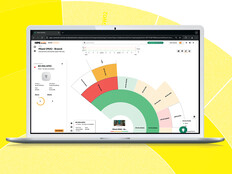SD-WAN Helps to Control Costs and Secure the Enterprise
A software-defined approach can give governments a leg up in a number of key areas.
The programmable nature of SD-WAN, with its inherent flexibility, gives agencies newfound agility. This includes “the ability to dynamically route traffic along the optimum path to that application,” Moffett says. “Let’s say you had an outage at some point; with SD-WAN, you could effectively route around that.”
The higher performance and reliability of SD-WAN in turn serves to support modernization at all levels. “Compared with legacy WANs, SD-WAN can improve application performance as much as tenfold,” Shoultz says. “IT groups can meet application-level SLAs directly tied to user satisfaction, no matter where they are located.”
As an added benefit, SD-WAN can help agencies to better manage costs. “Instead of having a dedicated circuit that goes back to the data center, you could use commodity internet connections that are much less expensive,” Moffett says. “You can use fixed wireless coming into a site, or you could use 5G LTE. SD-WAN effectively lets you support locally any type of circuitry, which lowers your cost.”
For state and local entities looking to implement SD-WAN, a number of best practices can help them make the most of this powerful capability.
Agencies can leverage SD-WAN to elevate cybersecurity. “People talk a lot today about secure access service edge, or SASE. SD-WAN is a key element of that,” Moffett says.
“Maybe you’re continuing to do some on-premises security,” he says. “You can take that traffic now from a branch or a home user and send that directly into a security cloud without having to hairpin that back to a corporate data center.”
Agencies also can tie SD-WAN to an SD-LAN to improve worker experience and citizen engagement.
“You can combine SD-WAN and SD-LAN under an AI-driven enterprise architecture that uses microservices,” Caruso says. “That allows folks to look at service levels on experience from every device that’s connected to the network. It gives applications visibility into how the network is behaving. Then you’re really going down that path from client to cloud.”
EXPLORE: Hybrid work solutions helping modernize both government services and workplaces.
How SD-WAN Better Supports Hybrid Work
Government agencies increasingly are looking at SD-WAN as a way to support the hybrid workforce.
“Even after the smoke clears, the average government worker is going to spend probably two days a week not in an office proper,” Moffett says. “That means you have distributed not only all of your applications, but also your workforce. Your people can come in from anywhere.”
No one knows for sure how this will impact the network. “As governments reopen their branch offices, the number of employees returning and the bandwidth needed are still unknown and inconsistent,” Shoultz says.
Faced with such uncertainty, existing solutions will prove problematic, as they do not support flexible consumption. SD-WAN, on the other hand, “offers a flexible, subscription-based model that enables customers to reduce WAN costs and purchase SD-WAN subscriptions as an aggregated pool that can be flexibly distributed to each site,” he says.
SD-WAN can help ensure a higher degree of cyber resiliency in the remote work environment and can support productivity in the hybrid workforce, Caruso says.
With the ability to define specific policies and protocols, supported by capabilities such as secure vector routing or smart session routing, “it becomes zero trust,” Caruso says.
He adds, “You can deny by default, meaning there’s a policy for any user who needs to get to an application in the cloud. Those policies are very strict: No inbound traffic can come into their network, but they can certainly get to everything they need.”
And the flexibility of a software-defined network can ensure productivity as well. With SD-WAN, “it's easier to identify when there are network issues because of the visibility we have on the network,” Caruso says. “You don't want to be chasing ghosts when people are having network issues.”












